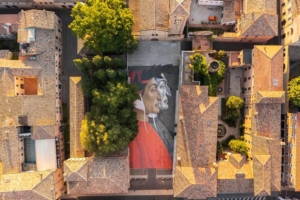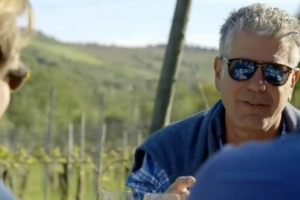Ravenna Food: 11 must-try dishes & where to taste them
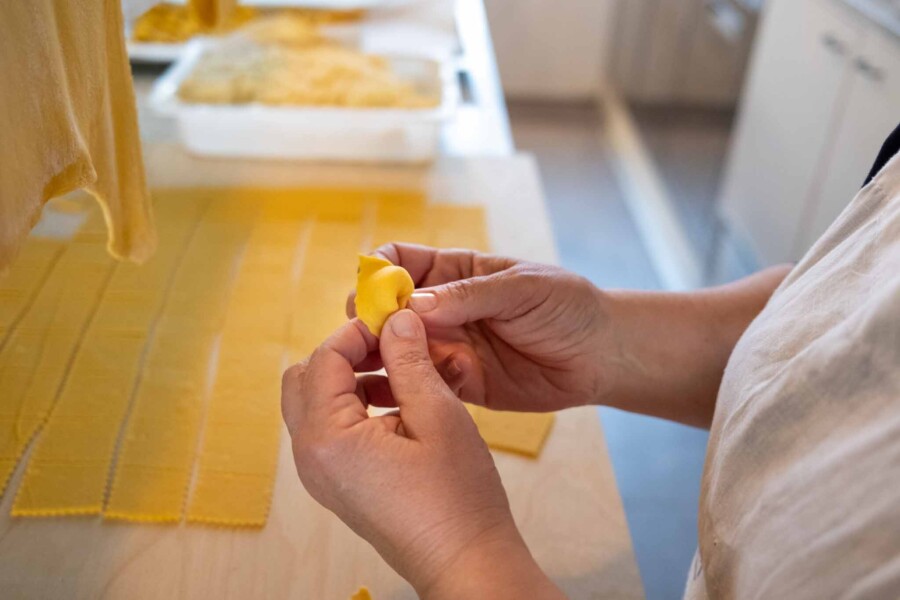
If you're a foodie looking for an unforgettable culinary experience, Ravenna food should be at the top of your list.
This charming Italian city, famous for its mosaics, is also a treasure trove of gastronomic delights.
From traditional piadina to indulgent desserts, Ravenna offers a taste of Romagna's rich culinary heritage.
Curious to know what you must eat when visiting?
Here's your guide to the 11 best foods in Ravenna that will make your trip truly memorable.
No list of Ravenna food is complete without mentioning piadina, a flatbread that embodies the spirit of Romagna’s cuisine.
Often called the "bread of the people," piadina has been a staple of the region since the Middle Ages, cooked on hot griddles and filled with fresh, seasonal ingredients.
But what is piadina, exactly?
It’s a simple unleavened flatbread made from flour, water, lard (or olive oil), and a pinch of salt.
Yet its simplicity is what makes it so versatile.
Traditionally, piadina was a farmer's meal, but today, it’s enjoyed by everyone—from locals grabbing a quick lunch to travelers eager to taste an authentic Romagnolo specialty.
Piadina originates from the Romagna side of the Emilia-Romagna region.
However, its preparation varies depending on where you are.
In Ravenna, the piadina tends to be slightly thicker and softer, making it perfect for wrapping hearty fillings like squacquerone cheese, prosciutto crudo, and arugula.
In Rimini, by contrast, piadinas are thinner and crispier, giving a different texture entirely. This diversity makes it exciting to try piadina across the region.
How do you eat piadina?
That’s the fun part—you can eat it in so many ways!
Fold it in half like a taco, wrap it like a burrito, or stack one on top of another like an Italian quesadilla.
Whether you go for a savory filling of cured meats and cheeses or a sweet combination like Nutella and bananas, each bite bursts with flavor.
Best with: squacquerone dop, prosciutto crudo, arugula, or sweet with Nutella.
Try it in: kiosks in Ravenna's old town or seaside piadinerie at Marina di Ravenna.
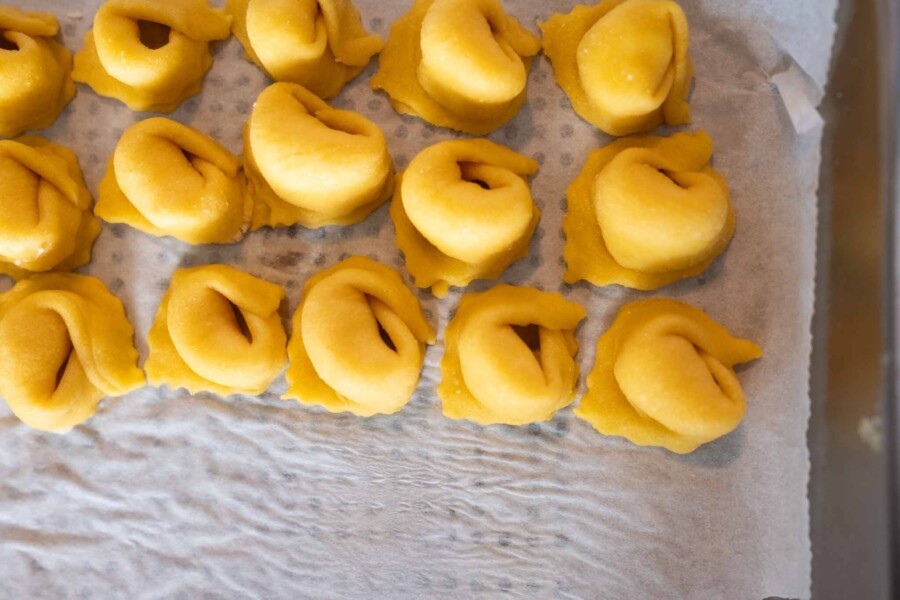
If there’s one dish that embodies the warmth and love of Romagna’s culinary traditions, it’s cappelletti.
These small, hat-shaped pasta parcels are a true comfort food, made to bring people together around the dinner table.
What is the meaning of cappelletti pasta?
The name "cappelletti" literally translates to "little hats," a reference to their unique shape. Each parcel is carefully hand-rolled and filled with a mixture of cheese, meat, or vegetables, depending on the recipe.
Cappelletti holds a special place in the hearts of locals, especially during holidays or family celebrations.
Traditionally, it’s served in a rich, clear broth—a dish that’s simple yet profoundly satisfying.
Imagine a steaming bowl of cappelletti, the aroma of the broth wafting through the air, and the first bite revealing a delicate explosion of flavor.
While the classic way is to enjoy them in broth, you’ll also find them paired with hearty sauces like meat ragù or creamy cheese-based dressings in some restaurants.
Both versions are delicious, but the broth version carries the true essence of Romagna’s tradition.
One question many visitors ask is, “Is cappelletti the same as tortellini?”
The answer is no.
Though similar in appearance, cappelletti is typically larger, with a different fold and filling.
Tortellini often features a mix of pork and cheese, while cappelletti’s filling is softer and more nuanced, showcasing ingredients like ricotta and Parmesan.
Ready to taste this iconic dish?
Many of the Ravenna best restaurants serve cappelletti prepared just like the locals love it.
Be sure to try it for an authentic experience.
Best with: clear broth for tradition, or ragù for a hearty twist.
Try it in: classic trattorie near basilica di san vitale or along via cavour.
Passatelli might not be as famous as piadina or cappelletti, but it’s one of Ravenna’s hidden gems.
These rustic pasta strands are made from a mix of breadcrumbs, eggs, Parmesan cheese, and nutmeg.
Pressed through a special tool called an iron for passatelli, they emerge as thick, irregular noodles that embody the humble yet flavorful roots of Romagna’s cuisine.
Traditionally, passatelli is served in a hot, savory broth, much like cappelletti, making it a perfect comfort food for colder months.
Want a modern twist?
Many restaurants in Ravenna now serve passatelli asciutti (dry), pairing it with creative sauces like seafood ragù or porcini mushrooms.
Both versions celebrate the unique character of this dish, giving you a taste of tradition and innovation on one plate.
Best with: broth in winter, or seafood ragù for a coastal twist.
Try it in: trattorie in Ravenna’s old town, or learn to make them in a local cooking class.
No exploration of Ravenna food would be complete without a glass of Albana wine.
This golden white wine is more than just a drink—it’s a cultural symbol of Romagna.
In fact, Albana holds the honor of being the first white wine to receive DOCG status, Italy’s highest wine classification.
Albana is incredibly versatile.
- The dry version pairs wonderfully with savory dishes like piadina and passatelli, enhancing their flavors without overpowering them.
- For dessert, the sweet version of Albana is the perfect match for pesche dolci, creating a harmonious end to any meal.
Best with: piadina or seafood (dry Albana); pesche dolci or ciambella (sweet Albana).
Try it in: enotecas in Ravenna’s historic center, often by the glass.
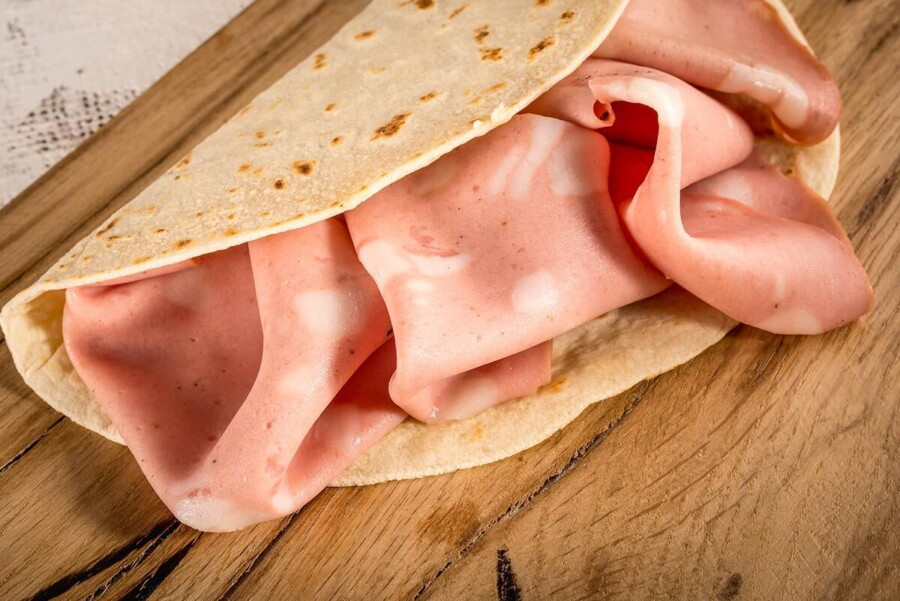
The Pesche dolci are not baked peaches, but rather a dessert masterpiece made of two halves of soft, delicate pastry shells.
These are no ordinary shortcrust pastries; they are crafted using the same dough as the traditional ciambella Romagnola, filled with rich pastry cream—classic or chocolate—then dipped in Alchermes liqueur and rolled in granulated sugar.
The result?
A true explosion of flavors.
Once a Sunday ritual in Romagna, this dessert held a special role in family gatherings.
In the city, the head of the family would stop by the pastry shop to pick up a tray of these treats.
In rural areas, where conveniences were fewer, the lady of the house would bake desserts herself, using them to sanctify family time with something truly special.
Known as "Pisgheini" in the local dialect, pesche dolci continue to be a hallmark of Ravenna’s culinary heritage.
They symbolize the joy of sharing and the importance of celebrating with loved ones.
Best with: sweet Albana or cagnina, for a dessert pairing that feels festive.
Try it in: pastry shops around Mercato Coperto di Ravenna or neighborhood bakeries.
Crescione, also known locally as cassone, might look like a piadina at first glance—but one bite tells a different story.
Unlike piadina, which is cooked flat and then filled, crescione is folded over raw filling, sealed along the edges, and cooked until the dough is golden and the inside warm and melty. This technique traps the aromas and makes every bite steamy and flavorful.
Fillings range from simple wild herbs, such as “stridoli” (Silene), sautéed with garlic and olive oil, to richer combinations, including potato and pumpkin purée, tomato and mozzarella, or spicy salami with cheese.
In the countryside, crescione was once nicknamed “the farmer’s pizza” because it required no plates and was eaten hot straight from the griddle. Today, it’s still a favorite street food—perfect for a quick meal you can carry in your hand.
Best with: a dry Albana or a light Sangiovese.
Try it in: the historic center or at kiosks along the seafront in Marina di Ravenna.
Squacquerone di Romagna DOP is the cheese that defines Romagna’s comfort food.
Fresh, white, and irresistibly creamy, its name comes from the dialect word “squacquerare”—to melt or collapse—because of its soft, spreadable texture. It’s mildly tangy with a sweet, milky finish that makes it the perfect partner for piadina.
Traditionally, squacquerone was made in small family dairies and eaten within a few days of production.
Its protected DOP status ensures it’s still crafted in the Romagna area with the same care. Pair it with peppery arugula and prosciutto crudo inside a warm piadina, and you get the classic combination that locals never tire of.
Beyond piadina, you’ll also find squacquerone paired with figs, drizzled with Saba (grape must syrup), or spread on toasted bread for aperitivo. It’s a cheese that adapts to both rustic and refined tables.
Best with: piadina + prosciutto + arugula trio.
Try it in: markets and traditional piadinerie; look for dop on the label.
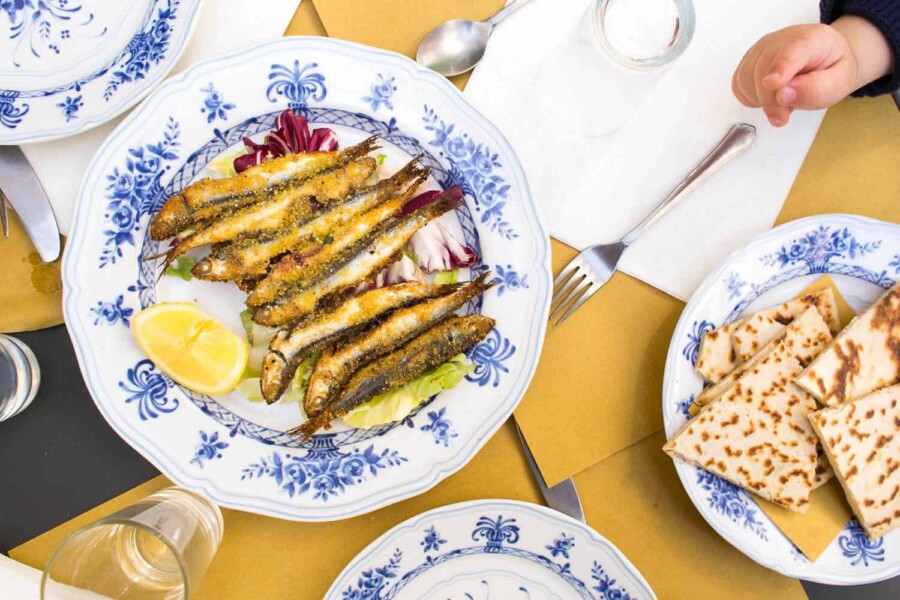
Ravenna’s cuisine isn’t just about pasta and bread; the Adriatic Sea brings another dimension.
Sardoncini, small bluefish similar to anchovies or sardines, are a summer staple along the coast. Grilled simply with olive oil, breadcrumbs, and parsley, they embody the Adriatic idea that less is more.
These fish were once considered humble food for fishermen, often eaten straight off the grill at the docks. Today, they’re celebrated in seaside trattorie, where you’ll also find fritto misto (mixed fried seafood) or charcoal-grilled platters that combine calamari, shrimp, and sardoncini.
Piadina is often served on the side—yes, even with fish!—to mop up the juices.
The smoky, briny flavors capture the essence of Ravenna by the sea, especially at sunset with a chilled glass of local wine.
Best with: pagadebit (fresh and floral) or a chilled dry Albana.
Try it in: Marina di Ravenna and Porto Corsini at casual seafood spots.
Formaggio di Fossa di Sogliano is one of Romagna’s most intriguing flavors.
This cheese is aged in underground pits—fosse—lined with straw, sealed, and left for months to ferment in near-anaerobic conditions. When unearthed, it emerges with a sharp, nutty, slightly spicy aroma unlike any other cheese.
Once, this unusual method was a way to hide food from invaders or tax collectors.
Today, it’s a celebrated tradition, and the cheese carries a DOP status. The result is crumbly, complex, and deeply aromatic, with notes of truffle, nuts, and hay.
Shaved over cappelletti, paired with Saba or honey, or enjoyed with rustic bread and a glass of wine, Formaggio di Fossa is not for the faint of heart — but cheese lovers will fall in love.
Best with: medium-bodied sangiovese di romagna.
Try it in: wine bars and traditional trattorie; ask for it “a scaglie”.
Despite its name, Romagna’s Ciambella is nothing like an American donut. It’s a rustic, oval-shaped cake made with flour, sugar, eggs, butter (or oil), and flavored with lemon zest, anise, or even orange.
Baked to a golden crust, it’s slightly crumbly, making it perfect for dunking.
Ciambella has long been a Sunday and holiday tradition.
In rural areas, it was baked in wood-fired ovens and served at weddings or family gatherings. In some towns, pieces of Ciambella were dipped in red wine at celebrations, a practice that survives today among older generations.
Though simple, it’s a dessert that carries nostalgia: ask locals, and many will recall childhood afternoons ending with a slice of Ciambella and a glass of warm milk.
Today, pastry shops offer it daily, sometimes glazed with sugar crystals or filled with jam (mostarda).
Best with: sweet Albana or a splash of Cagnina.
Try it in: neighborhood bakeries and pastry shops across the center.
Romagna is wine country, and beyond Albana there are three labels every visitor should try. Pagadebit—whose name means “to pay debts”—is a crisp, floral white once considered so reliable that farmers could “pay their debts” with its harvest. It’s refreshing and pairs perfectly with seafood or crescione.
Cagnina, on the other hand, is a sweet red with low alcohol, traditionally poured during autumn grape harvests. It’s a natural partner for Ciambella, roasted chestnuts, or Pesche Dolci.
Locals drink it in small glasses, almost like a treat.
Last but not least, Sangiovese di Romagna comes in many styles: young and fruity for casual meals, or aged in oak for serious dinners. It’s the go-to wine with ragù, grilled meats, and cave-aged cheeses like Formaggio di Fossa.
This trio represents everyday life in Ravenna: simple, authentic, and tied to both land and season.
Best with: match wine to dish; don’t fear the sweet-savory pairings.
Try it in: enotecas around the historic center and near Mercato Coperto food market.
Conclusion: plan your culinary adventure in Ravenna
From the iconic piadina to the indulgent pesche dolci, Ravenna’s food scene is a celebration of tradition and flavor.
Each dish tells a story of the region’s history and its love for fresh, high-quality ingredients.
Are you ready to experience the best of Ravenna food for yourself?
Combine this gastronomic journey with the city’s stunning mosaics by booking our Ravenna tour.
Don’t just visit Ravenna—taste it!
